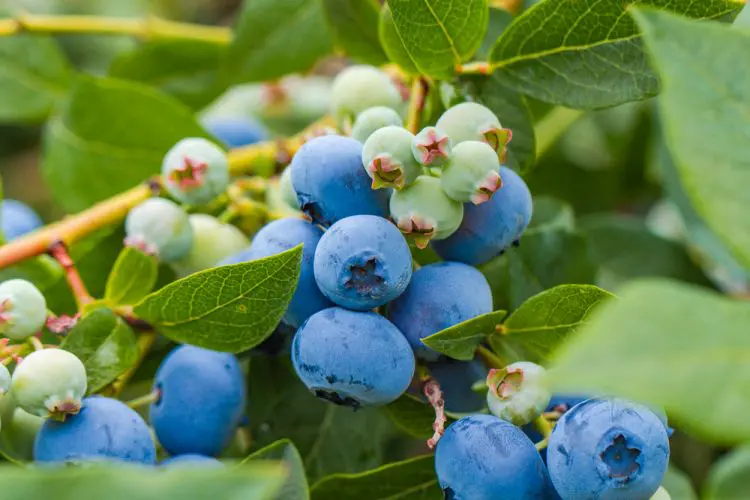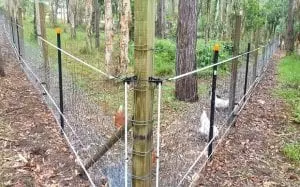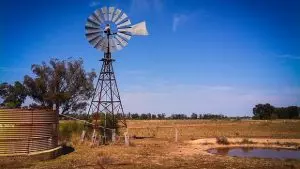Recently I was asked if it is possible to grow blueberries in the ground in my area, and in Australia in general. The answer is ‘yes- as long as you create the right soil for blueberries first‘. Blueberries require an acidic soil, but most natural soils in Australia are quite alkaline. This means that you’ll need to create that acidity before planting blueberries.

Creating acidic soil in the ground requires about 3 months preparation. Briefly, the process is as follows. Start by digging a large planting hole around 500 mm (20″) deep. The soil should be loosened and soft with lots of organic matter, including an acidifier thoroughly mixed through. The pH will them slowly reduce to a pH of 5 or less. All soils and growing media have a natural pH range and will organically revert to that value over time, so soil pH is something that you’ll need to monitor regularly.

1. Make Acidic Compost
Creating soil with the low pH of 5 first requires an acidic compost. You can make one specially from fine wood chips. The size of the woodchips is important because reducing the pH value of your soil is partly reliant on the chips being fine enough to break down quickly. Be aware that different woods have different pH values, so it’s best to start with one like pine that is acidic. The acidity of a species of wood depends primarily on its tannin content. Generally speaking, the lighter-coloured the wood, the lower the tannin content will be. Other woods that are suitable for making an acidic compost are elm, oak, douglas fir, spruce, hemlock and scots pine.

2. Digging the Hole & Preparing the Soil
The next step is to dig the planting hole and thoroughly prepare the soil for your blueberries. Be mindful of your placement, and make sure the position has adequate drainage, as blueberries hate wet feet.
Dig a hole of around 700-800mm (27-31″) across and at least 500mmm (20″) deep. Mound the soil from the planting hole up around the edges, and collect a sample for a pH test. This is your base reading, and will tell you what you’re working with. It tells you how much acidifying agent to add and approximately how long you’ll need to wait for it to work.
Then mix the following ingredients with some of your natural soil and refill the planting hole with this mixture.
- 2-3 buckets of fine wood chip
- 2 buckets of soaked cocopeat
- 2 buckets of acidic compost
- half a bucket of of chicken manure pellets or composted fresh manure
- elemental sulphur
The elemental sulphur should be sprinkled throughout the mixture according to the directions on the pack. Once in the planting hole, your new mixture will form a big mound that slowly composts down. Water the mix well, but don’t work the soil once watered. Cover with soft mulch and leave for 2-3 weeks to begin the acidifying process.

Check the soil pH level after 2-3 weeks. There may be little change during this initial period, as the acidifying microbes need time to multiply. But it will slowly start dropping. If, after 6 weeks, there has been no real change, dig the hole out. Sprinkle more sulphur across the contents (according to pack instructions) and add more healthy compost full of bio-life. Refill the hole, mulch and water again.
Some advise the use of vinegar to acidify soil. Please don’t use vinegar as its low pH of 3.2 kills the natural fungal & bacterial bio-life in your organic soil. Most vinegar is simply acetic acid which is an industrial by-product diluted with water.
Planting Your Blueberry
Don’t rush to plant your blueberry- this is a surefire way to lose it! If the soil pH at the root zone is not 5 or less, the plant may go into shock, so you need to give the soil time to settle & develop the necessary pH. In the case that you’ve used fresh manure, remember that it will initially heat up & make the root zone too hot for the plant. After 3 months, your planting hole should be full of loamy friable acidic soil, ready to accept your precious blueberry plant.
Now comes the easy part- plant your blueberry and keep it well-watered. Just like ginger, blueberries love water flowing over their roots but hate being waterlogged. At the same time, they hate hard & dry soil, so will suffer if left unwatered in dry conditions for more than 2-3 days. After planting, sprinkle a slow-release acidic fertiliser around the plant before mulching. One that has been specially formulated for gardenias, azaleas and hydrangeas is ideal. Blueberries are water-hungry, especially in a hot climate, and respond well to irrigation lines. Use drippers that deliver at least 4 litres (4 quarts) per 30 minutes, and up to twice that rate in a dry tropical zone. Use dripper line watering 2-3 times per day or every second day in more moist climates.
The roots of your blueberry plant will fill that hole in a few months. Every six months, dig 300 mm down the side of the planting hole to check the pH. Since it can take 3 months to lower the pH, you must be vigilant & test it regularly. If you find the pH creeping up or the plant is exhibiting signs of pH stress, loosen all the soil with a potato fork. Drive numerous holes deep down into the root mass and pour in a liquid acidifier following the instructions on the pack.

Notes on Blueberry Cultivars
Blueberry cultivars come from North America. There are three types: southern highbush, rabbit eye and northern highbush. Southern highbush and rabbit eye varieties are suited to warmer climates and northern highbush types to cold, temperate areas.
In Australia, northern highbush varieties will do well in our colder southern areas because they require night-time chill hours to prompt flowering and fruit set. Chill hours refers to the accumulated cold hours between 0 and 7 degrees celsius (32-45F). Northern highbush types generally need over 400 chill hours and may need as much as 1000 hours, so are best suited to a cold climate.
Those growing blueberries in a warm climate such as Florida or south-east QLD will do better with a southern highbush type like the biloxi, which requires very little winter chilling. No matter where you live, you will be able to find a blueberry that you can grow in the ground.













